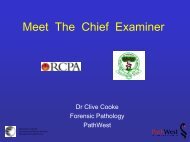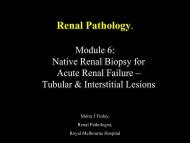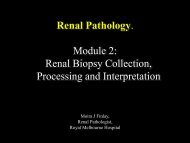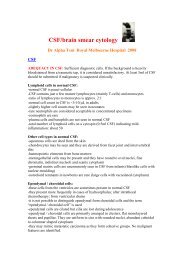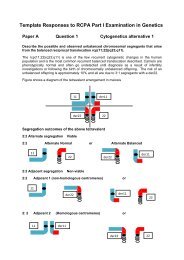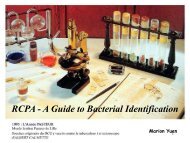RCPA Examinations in Anatomical pathology - Questions ... - Rcpa.tv
RCPA Examinations in Anatomical pathology - Questions ... - Rcpa.tv
RCPA Examinations in Anatomical pathology - Questions ... - Rcpa.tv
You also want an ePaper? Increase the reach of your titles
YUMPU automatically turns print PDFs into web optimized ePapers that Google loves.
Case 10: Male 4 days old –<br />
neonatal liver failure and death<br />
• MICROSCOPIC<br />
• The hepatic architecture appears to have been <strong>in</strong>tact with normal central ve<strong>in</strong> - portal<br />
tract relationships. Geographic areas of acute hepatocellular necrosis n<br />
with very little<br />
<strong>in</strong>flammation are present. With<strong>in</strong> the areas of necrosis there are e degenerate cells<br />
with eos<strong>in</strong>ophilic nuclear <strong>in</strong>clusions and marg<strong>in</strong>ated chromat<strong>in</strong>. These <strong>in</strong>clusions<br />
appear to be viral <strong>in</strong> nature. Cytoplasmic <strong>in</strong>clusions are unable e to be identified and<br />
the nuclei do not appear to the markedly enlarged.<br />
• Comment<br />
• The viral <strong>in</strong>clusions are consistent with herpes virus <strong>in</strong>fection and<br />
immunohistochemistry for HSV 1 and HSV 2 as well as PCR for herpes es virus 1 and<br />
herpes virus 2 will be undertaken to confirm the nature of the virus. v<br />
The morphology<br />
of the <strong>in</strong>fected cells is not typical for cytomegalovirus and the necrosis and the type<br />
of cells <strong>in</strong>fected are not typical for parvovirus B 19 however immunohistochemistry<br />
munohistochemistry<br />
and PCR can also be undertaken to exclude these diagnoses.<br />
• SUMMARY<br />
• Liver: Herpes simplex virus <strong>in</strong>fection.




